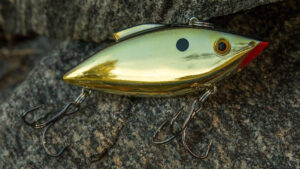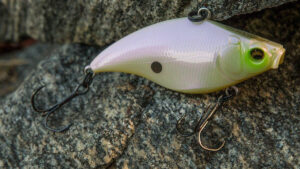Lipless crankbaits are a major player in the bass fishing arena; they’ll cast a country mile, you can retrieve ‘em at any speed and most importantly, big fish have a hard time resisting them. But with the endless color choices in today’s market, it’s hard to narrow your choices and avoid spending a bunch of money. So where do you start?
That’s what this guide is for. Will other colors and patterns catch fish? Absolutely. But this is a great baseline from which to make future color selections when you’re buying lipless crankbaits.
You simply cannot go wrong with these colors.
Color No. 1: Silver
Conditions: Sunny or cloudy, clear water
Lure pictured: Bill Lewis Rat-L-Trap in Chrome Black Back
When most folks are looking at lipless crankbaits, they’re going to be immediately drawn towards this color. It makes total sense: Most baitfish we see are silver, so we match the hatch. I’ve caught fish on this color in nearly every situation imaginable, but you’ll have your most consistent success when using silver lipless crankbaits in relatively clear water.
The flash of this color has a lot of drawing power in clear water. This means that the bass will see it from a few feet away and come towards it to attack it. Combine a tight, wiggling action, loud rattles and an intriguing baitfish-like color scheme and you have all the makings for a darn good day on the water.
Color No. 2: Gold
Conditions: Sunny, stained water
Lure pictured: Bill Lewis Rat-L-Trap in Gold
If you find yourself fishing stained water in sunny conditions, it’s hard to beat some sort of gold-colored lipless crankbait. Gold colors penetrate dirty water much better than silver or chrome, which of course increases the likelihood of a bass tracking it down. We’re still taking advantage of the sun by using a reflective color, but just in a different hue to increase visibility.
You don’t need to get too picky on the different color patterns here; you could probably spray paint your favorite lipless bait gold and catch fish— but don’t do that, I’m just making a point.
Personally speaking, I prefer a darker back to my gold lipless baits in order to provide a bit more contrast and flash as it wiggles back and forth.
Color No. 3: White
Conditions: Cloudy, clear water
Lure pictured: Megabass Vibration-X Jr. Rattle In in Bahama Milk Pearl
You’re bound to have some really good days of fishing with this combination. Reflectiveness and flash isn’t such a big deal in cloudy weather because there’s no prominent light source. This means opaque colors will provide a much more noticeable underwater silhouette.
There are a lot of different white color patterns on the market. Some have green backs, some have some lateral chartreuse striping going on and others might be solid white. They will all catch fish as long as the sides—the largest surface area on the lure—are prominently white. If you catch more fish on one white color pattern than the others, stick with it. Confidence is your best friend.
Color No. 4: Chartreuse
Conditions: Cloudy, stained water
Lure pictured: Megabass Vibration-X Jr. Rattle In in GLX Western Chartreuse
I’m surprised more people don’t own chartreuse lipless crankbaits. I’ve seen some big-time beatdowns with this color under cloudy conditions and in stained water. One of my buddies co-anglers wrecked an almost 20-pound, 3-fish limit on Lake Seminole a few years ago with this combination.
Again, since there’s no sun to add any flash to the lure, an opaque color is favorable for an optimal silhouette. Bright colors are known producers in dirty water, so you’re left with a chartreuse lipless crankbait. It might take you a while to gain confidence in such a funky looking plug, but stick with it—it will work if you’re around fish.
Color No. 5: Red
Conditions: Stained water
Lure pictured: Lucky Craft LV 500 in Spring Craw
This color could be considered the mind-blower of this guide. Red-colored lipless crankbaits work excellently in the prespawn period and surprisingly enough, they put off some really good contrast in dirty water; especially if they have an orange belly.
For whatever reason, this color is a major player on nearly every prominent grass fishery in America. There are different theories as to why it’s so productive, but we’ll leave that to other folks. In my personal experience, I have not visited a grass fishery whose bass don’t go nuts for a crawfish-colored lipless crankbait.
















